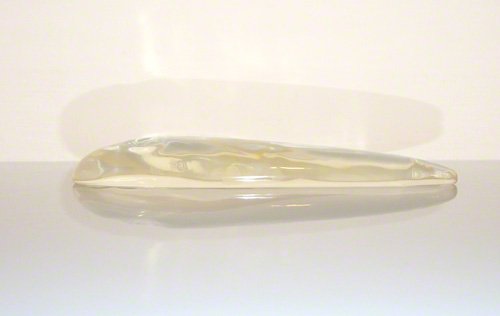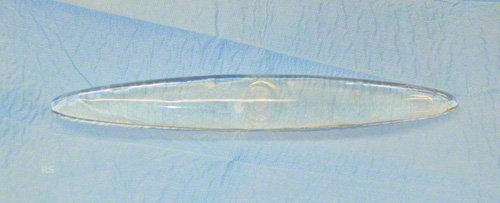
Image: Calf implant filled with silicone gel. This is a so-called anatomical implant.
What are calf implants made of?
Image: Spindle-shaped calf implant with silicone gel filling. At the right end you can see a U-shaped loop shimmering through, which serves to anchor the guide rod during implantation.

While breast augmentation using breast implants is an everyday procedure for plastic surgeons. The demand for calf augmentation (see also calf correction) using calf implants is significantly lower. However, the quality of calf implants has also improved as a result of developments in breast implants.
Today, silicone gel is the standard instead of liquid silicone. This is also known as cohesive silicone gel. The stability of the outer shell is significantly increased, so that the likelihood of breakage is low even in the event of severe bruises and impacts. Calf implants can withstand the strain on the calf.
A rough surface has not prevailed here, as the implants are placed in the muscle box of the gastrocnemius muscle, where capsular fibrosis (hardening of the implant capsule) is extremely rare. Furthermore, the implants have to be pushed through very small incisions (4 cm) to a depth of 30 cm, which would hardly be possible with a rough surface.
The calf implants described here, which consist of a solid shell and are filled with silicone gel, are most commonly used. However, there are also solid, i.e. firm rubber-like implants, which are described below.
Is silicone safe?
Silicone is used in medicine for drains, implants (not just breast implants) and for the care of instruments.
In the past, silicone has been suspected of promoting breast cancer and rheumatic or autoimmune diseases. This led to large-scale studies, particularly in the USA, which were able to refute these allegations.
Silicone is now one of the best-studied materials in medicine. It is considered a safe material. You will find the most important studies at the bottom of this page.
In what forms are calf implants available?
In principle, two basic shapes have become established, which you can also see in the pictures:
- Anatomical calf implants: They are raised on one side and therefore emphasize the upper third of the calf. They are usually used in men to emphasize the upper calf muscles. Patients who suffer from calf hypotrophy (thickened calves) after clubfoot surgery in childhood also benefit from this form.
- Spindle-shaped calf implants: They are slimmer than the anatomical calf implants and are used in particular for shaping female calves. Depending on the findings and implant size, these implants can also be used to correct the middle and lower section of the calf.
Solid, customizable calf implants
In addition to the calf implants with silicone gel filling described above, there are also implants that are solid, i.e. made of solid silicone. These implants can be customized, which can be particularly advantageous for calf deformities caused by injuries or operations.
Corresponding companies manufacture these calf implants on the basis of a plaster cast, so that the estimation of the required shape is quite accurate.
What are the advantages and disadvantages of solid or silicone gel implants?
Advantages of standard implants:
- more favorable
- Less effort during production
- As they are soft, you can often hardly feel them.
- No plaster cast necessary
Advantages of solid calf implants:
- Individual shapes can be produced
- They can also be trimmed during the operation.
Disadvantages of standard implants:
- only prefabricated molds
- No intraoperative molding possible
Disadvantages of solid calf implants:
- Very firm and therefore often palpable
- Significantly more expensive
- more complex to manufacture
- Plaster cast required
What are calf expanders?
Calf expanders are also calf implants, although they are rarely used. Expanders are silicone sleeves that can be filled via a valve. The expander is implanted in the calf at the point where the filling effect is desired.
The valve, which is connected to the expander via a small silicone tube, is inserted under the skin where it can be easily felt. Saline solution can now be filled into the expander via the valve week after week, gradually filling the chamber and causing the calf implant to swell.
The expansion stretches the tissue and creates a cavity that serves as a space for the final calf implant. The tissue expansion must take place over approx. 6 weeks for the effect to be permanent. The amount and speed of filling depends on the tissue, the desired tissue expansion and the patient’s perception of pain.
When does it make sense to use an expander?
Whenever extreme calf findings are involved. For example, after injuries, burns and in cases of calf hypotrophy that has existed since childhood. In these cases, there is a lack of tissue, so that even the implantation of medium-sized calf implants can cause massive intraoperative problems due to the tight conditions.
Studies on the topic of silicone implants
The largest studies on silicone implants were carried out in the area of breast implants. The studies presented here are also valid for calf implants, as these are also made of silicone.
- June 1999; National Academy Institute of Medicine; Conclusion: Connective tissue disease, cancer, neurological disease and other systemic conditions are no more common in women with silicone breast implants than in women without silicone implants.
- 1998; Sturrock R.D., FRCP, Independent Review Group (IRG); Conclusion: There is no association between silicone implants and connective tissue diseases …
- 1998; European Committee on Quality Assurance and Medical Devices in Plastic Surgery; Conclusion: Autoimmune or connective tissue diseases are not associated with breast implants. Furthermore, it is pointed out that current studies refute malignant degeneration caused by silicone-filled breast implants.

